In this piece
How publishers are learning to create and distribute news on TikTok
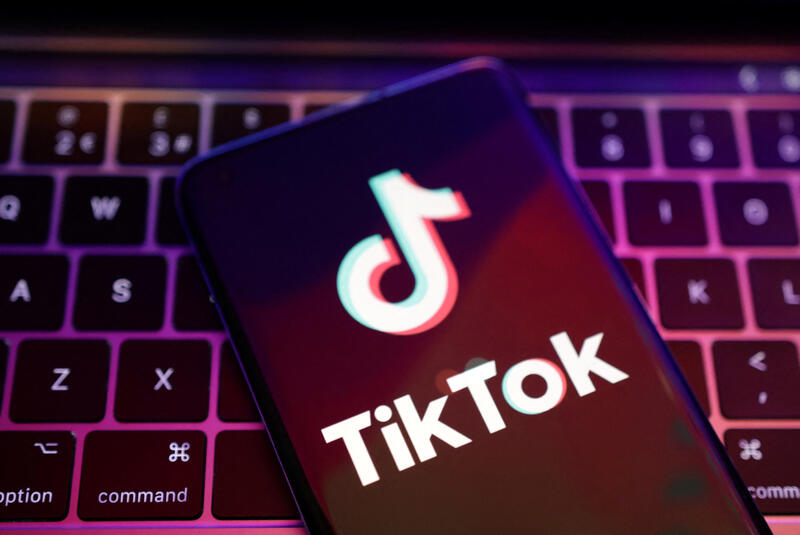
REUTERS/Dado Ruvic/Illustration
In this piece
1. Introduction and key findings↑ | 2. Methodology↑ | 3. How and why publishers are moving onto TikTok↑ | 4. TikTok’s ‘magic’ algorithm – how it works↑ | 5. What strategies are publishers pursuing on TikTok?↑ | 6. News creators and activists↑ | 7. What next for TikTok and news?↑ | Conclusion ↑ | About the Author↑ | Acknowledgements ↑ | FootnotesDOI: 10.60625/risj-gfyx-3v66
1. Introduction and key findings ↑
TikTok is currently one of the world’s fastest-growing social networks with its addictive algorithm surfacing an endless stream of short, entertaining videos. Until recently the network had a reputation built almost exclusively on fast-moving, funny or musical memes, but stories such as Black Lives Matter, the Covid-19 pandemic, and the war in Ukraine have helped make news a much bigger part of the mix. Changes to the platform, enabling longer videos and the promotion of live streams, have also made TikTok more attractive for news publishers looking to engage younger audiences.
Despite this, our Reuters Institute Digital News Report research suggests that news on TikTok is still mostly generated by social media influencers, activists, or ordinary people rather than by journalists.1 Qualitative studies of younger consumers show that although TikTok is loved for its humour and engaging presentation, many worry about the credibility of the information they see there and the potential for misinformation and disinformation.2
Understanding the nature of news on any social platform is a huge endeavour given the highly personalised nature of the experience and the limited availability of public data. Partly for these reasons, in this report we focus mainly on the production of content for TikTok by publishers, as well as some independent news creators. We have tracked the extent of publisher activity across more than 40 countries, one of the first attempts to do this, and interviewed some of the most successful news organisations such as the Washington Post, Sky News, and Le Monde about their motivations and key learnings.
As this fast-moving platform matures and grows, we have also identified areas in which TikTok itself may need to focus more on publisher concerns about the quality and range of news content provided and the transparency of take down rules. Given the number of publishers now involved – and the speed of change – this report should not be seen as a comprehensive picture of publisher activity, rather a snapshot that we hope contains insights that will be useful to news organisations, regulators, and researchers.
Key findings
- Around half (49%) of top news publishers are now regularly publishing content on TikTok – based on lists drawn from our 2022 Digital News Report covering 44 markets.3 A large proportion of these have joined TikTok in the last year.
- Publisher adoption is not evenly spread. The vast majority of Indonesian (90%), Australian (89%), Spanish (86%), French (86%), and UK (81%) publishers operate active accounts on TikTok, along with more than three-quarters in the United States (US) (77%), and around two-thirds in Brazil (68%). News organisations in Japan (31%), Italy (29%), Denmark (27%), and Bulgaria (7%) have been slower to move onto the platform.
- News organisations are attracted by the fast-growing audience and younger demographic, but they are also motivated by the desire to provide reliable news, amid fears about widespread misinformation on the platform.
- Other publishers are staying away or engaging cautiously. Some worry about the Chinese ownership of the platform and the potential implications for free speech; others fear that the ‘TikTok-ification of news’ risks trivialising important stories as well as undermining business models that depend on referral traffic from social networks.
- There is no single recipe for success on TikTok. A number of publishers use a strategy based on young creators who are native to the platform and its unique language. Others prefer to showcase the talents of the entire newsroom, making minimal changes to existing tone or content.
- The process for getting ‘verified’ status on TikTok seems to be opaque and inconsistently applied. Our research showed that many publishers with a strong track record for trusted content, including debunking and fact-checking, do not yet have a blue tick, especially outside the US and Western Europe.
- Going forwards, our interviewees say that publishers would like TikTok to offer greater prominence, more transparency, better monetisation opportunities, and access to more detailed demographic data. Many are unhappy that TikTok sometimes takes down or limits access to hard-hitting news stories from their accounts, arguing that legitimate news providers should be treated differently.
In this report, we start by setting out data on the extent of publisher adoption alongside motivations for joining TikTok. We pull together top tips from TikTok creators and discuss the metrics most commonly used to evaluate success. Next, we explore different strategies for engaging users on the platform, highlighting case studies from early pioneers as well as independent news creators and activists. Finally, we look at future opportunities for monetisation and ways in which publishers would like TikTok to better support reliable and trusted news sources.
2. Methodology ↑
In order to understand the extent of mainstream media involvement with TikTok, we identified the top news brands in 44 countries from our Digital News Report. We excluded India, where TikTok is banned, and Hong Kong, where it is unavailable. We looked at all brands that have significant online consumption in our 2022 survey4 and checked to see if those brands had a presence on TikTok and had posted in the previous week. In a very few cases, we also included socially native news organisations that have a very large following on TikTok, even though they did not meet our other criteria. In all cases, we noted the follower numbers for each brand and, in the case of the most successful, we also measured the average views from the last 50 posts and the date when they joined the platform.
It should be noted that the content of the TikTok accounts varied enormously from hard news to entertainment. We checked each account to ensure that the content was broadly news related. It is possible that we missed some news organisations for a variety of reasons: due to issues of language, unusual naming of brands on TikTok, or accidental oversight.
In order to root the report in audience understanding, this report also references consumption and demographic data about TikTok from the 2021 and 2022 Digital News Reports and from our supporting qualitative interviews. The majority of this research, however, is drawn from original interviews with 20 different news organisations and individuals. These include large companies such as the Washington Post, Sky News, the Guardian and Le Monde; digital-born brands like Infobae, Fanpage, and Nexo Jornal; socially native brands like Ac2ality, The News Movement, and Geopop; as well as some individual creators and activists. The interviews were conducted between 29 September and 7 November 2022. TikTok were not willing to provide an interview. They did, however, respond to specific queries and referred us to publicly available statements about news on the platform.
3. How and why publishers are moving onto TikTok ↑
TikTok is a social media app that was launched in 2018 by Chinese company Bytedance. Containing a mix of short videos often accompanied by some form of viral song or audio, it now has more than one billion active daily users.5 It has been the world’s most-downloaded mobile app since early 2020 and is especially popular with younger audiences (Figure 1), many of whom have started to turn away from more traditional networks like Facebook.
A turning point for the platform seems to have been Covid-19 lockdowns, when many young people, trapped at home, experimented with the video app and its simple editing interface to share their experiences. Russia’s invasion of Ukraine further boosted the platform’s reputation for news, with young Ukrainians sharing eyewitness stories of life under bombardment in real time, and some news providers joining the platform for the first time.
Figure 1: Ukraine war boosted news coverage, especially with younger groups
Figure 2. Growth in TikTok for any purpose 2019–2022, selected countries.
Source: Digital News Report 2022 (Survey Jan/Feb 2022). Q12a. Which, if any, of the following have you used in the last week for
any purpose? Showing TikTok code. Base: Each market ≈ 2,000. Data not available for 2019 in Spain and Canada.
Some of the fastest growth has taken place in Latin American countries, such as Brazil, which have traditionally seen high adoption of new social networks (Figure 2). But we find even higher usage in parts of Asia and Africa (Figure 3).6 In some of these countries, TikTok growth has been fuelled by free or cheap usage as part of mobile phone data packages.
Figure 3: Markets with highest usage, selected countries
Driving adoption has been an easy-to-use app that, in contrast with other social networks, does not depend on up-front configuration such as following friends or celebrities. Instead, an algorithm learns what type of content a viewer likes and refines that over time. In qualitative studies for the Digital News Report, users talked about the magical nature of this algorithm and the fun and compelling experience:
3.1 News publishers and TikTok
Against this background it is not surprising that news publishers have begun to take TikTok seriously. Across 44 countries we find that around half (49%) of publishers are regularly updating TikTok accounts with news-related content (Figure 4). The fastest publisher adoption has been in some larger western European countries, including France, Spain, and the UK, as well as South-East Asia, Australia, the US, and Latin America. There has been less enthusiasm in Nordic countries, Japan, and eastern and central Europe. This largely mirrors areas with the highest consumption.
Figure 4
The list of the most-followed news accounts on TikTok (Figure 5) is dominated by publishers from countries with large populations, such as the US, Indonesia, Japan, the Philippines, and Brazil, but traditional news organisations from the UK and Thailand, Germany, France, and Spain are also strongly represented.
Having said that, it is striking how well some socially driven youth brands are performing in both Europe and the US. NowThis has more than 8.5m followers for its news and politics accounts while Spanish start-up Ac2ality, which has a mission to ‘tell the news in one minute’, has amassed 3.9 million followers since 2019. The French media brand Brut has more than 2.7 million for content aimed at under 35s. Fanpage (850,000) has brought a mix of investigations and fun to TikTok, where it is the biggest news outlet in Italy, and Vice World News has built 2.6 million followers in less than a year, picking up a top award in the process.7
Figure 5
It has long been thought, however, that follower counts on TikTok have less impact on the likely popularity of any particular post when compared with other platforms (See Chapter 4, How the TikTok Algorithm Works). This becomes clear when we re-order these most-followed brands by engagement, measured as average views per TikTok video (Figure 6).
On this basis, NBC News heads the lists with more than one million views per post, on average. Brazilian brands did particularly well, perhaps because our research covered the period of the 2022 election results. Both Globo’s G1 channel and Metropoles contained numerous individual videos with over 5 million views each. Yahoo! News US also scored highly with an average view count of 653,480, while ABC News, CBS News, the Daily Mail, and TV Asahi slipped down the list. Engagement with content tends to be much lower in countries like Indonesia and Thailand, despite the high follower counts for many TV news brands. This may be because most are pushing out available video clips with little attempt to re-version them for TikTok. By contrast, most brands at the top of this list, including socially native brands like NowThis, Ac2ality, Brut, and Vice World News, are putting considerable effort into the platform-specific content (see case studies in Chapter 5), and this is reflected in much higher engagement scores.
Figure 6

3.2 Why some publishers are embracing TikTok and others are holding back
The growth of TikTok has coincided with sometimes existential concerns from both publicly funded and commercial publishers about how to attract and engage younger audiences. Under 25s, in particular, are spending more time scrolling through apps like TikTok – around 57 minutes a day in the UK according to the media regulator Ofcom8 – and are less likely to go directly to news websites or apps.
Almost all the publishers we spoke to for this report recognised that they need to take their content to these audiences wherever they are: ‘It is a platform in which there are a lot of young readers, young viewers,’ says Fabrizio Barbato, CFO of Ciaopeople, which owns Fanpage and a number of other publishing verticals. ‘We thought that we should be present on it, even if there is no direct business model right now.’
Other publishers note that recent changes to the platform, such as the promotion of live-streaming and longer video lengths, have made it more conducive for news publishers: ‘It’s got huge reach. It’s got huge engagement,’ says Alan Strange, Editor for On-Demand content at Sky News. ‘But it’s not just a case of having to be there. We want to be there.’ Sky recently clocked up 16 million views for a live broadcast of the Queen’s funeral and tens of millions of views for a correspondent video from Ukraine. It now sees TikTok as one of its most important off-site platforms, along with YouTube.
The German publisher ARD was one of the first publishers to set up an account, in November 2019. ‘We have the task to transform our brand with younger audiences and inform society as a whole,’ says Patrick Weinhold, Head of Social Media for Tagesschau, who implemented a two-tier strategy of news and fun, which often involved creating ‘behind-the-scenes’ videos: ‘We wanted to make our brand more natural, more interactive, and more pleasant on a personal (eye-to-eye) level. Our brand image comes from a traditional, studio-based TV setting. We wanted to lighten this up.’
But TikTok is not an obvious choice for all. Some public broadcasters such as BBC News have been ambivalent, initially staying off the platform to focus on other networks such as Instagram. Other public broadcasters, including NRK (Norway), NHK (Japan), DR (Denmark), and Yle (Finland) have been slow to engage, partly due to worries that the tone may not be conducive to serious news or because of free-speech concerns related to the Chinese ownership of the platform. Many subscription-based publishers, such as the New York Times, have also stayed away, with limited prospects for monetisation a likely additional factor.
But other subscription publishers we spoke to are interested in TikTok because it offers the opportunity to build a relationship with younger audiences that they hope will pay off later. ‘We’ve done a good job developing a really large Instagram audience and the aim is to replicate that on TikTok,’ notes Liv Moloney, Head of Social Media at The Economist. ‘Also, with the trend to more vertical video on Instagram and YouTube, we thought why not push ourselves and go onto TikTok.’ Like many others, The Economist is not going ‘all in’ on TikTok. It has posted fewer than 50 videos since it started in July 2022 but has exceeded 20 million views and is busy experimenting with different approaches to see what works best.
In Sweden, a number of subscription-based publishers have joined the platform in 2022, including Sweden’s paper of record Dagens Nyheter and the tabloid Aftonbladet. The TikTok presence at Aftonbladet was part of a specific initiative to develop relationships with next-generation audiences. Future Editor Nathalie Mark has been tasked with identifying platforms and formats that build loyalty and reach. ‘TikTok is very important to that young audience, giving them news stories so that they later on may feel they go to Aftonbladet rather than go to the opposition,’ she says.
One other important reason cited by several interviewees relates to concerns about the spread of misinformation on the platform. Jan Žabka, a Czech journalist with the public interest website HlídacíPes.org, saw his young brother scrolling through his ‘For You’ page for up to seven hours a day and worried about the reliability of the news he was seeing. ‘It was sad that there were no news sites at the time from the Czech Republic – so I wanted to be there,’ he says. Žabka secured around €20,000 from innovation funds and foundations in the EU and the UK and has used the money to make TikTok videos to help improve news literacy on subjects such as maintaining online privacy, identifying different types of disinformation, and how to use open sources of information. ‘When I have a topic, I make three or five videos then I publish,’ he says.
Different types of misinformation explained on TikTok – HlídacíPes.org


Fact-checking and verification has also become a key part of the Washington Post’s strategy as the platform has matured. ‘There’s not a lot of fact-checking on the app and there’s quite a bit of misinformation,’ says Dave Jorgenson, one of the first journalists to adopt TikTok. In the early stages of the war in Ukraine the team identified a number of fake videos, and it now encourages users to tag their account so they can help to verify footage. ‘That’s very much the strategy, to focus on being the authority figure on the platform that can actually help you tell fact from fiction,’ says Jorgenson.
In summary, publishers are moving onto TikTok primarily because they want to engage younger audiences that are spending increasing amounts of time there. They are also motivated by a desire to combat misinformation with reliable news. The purity of the content-focused algorithm seems to match well with the speed and immediacy of news, but short videos do create constraints in terms of depth. Most traditional publishers are not focused on making money from TikTok at this stage, but rather see this as an opportunity to build relationships with younger people and experiment with new vertical video formats.
4. TikTok’s ‘magic’ algorithm – how it works ↑
The highly personalised algorithm is what makes TikTok so addictive. It learns what content you like based on a variety of signals including watch time, commenting, liking, and sharing. As soon as any video is published, it is shown to a handful of people on their ‘For You’ page. Based on how those people react – how long they watch, whether they like it, or how many friends they share it with – it is shown to another set of people until interest dies down.
Followers: This gives your video a head start as it is more likely to be shown to those that have expressed an interest, but as previously noted this is not as big a factor as on other platforms.
Views: This is the best metric for understanding how well a piece of content has done, and whether it is getting traction.
Complete rate: A good average watch time as a proportion of video length would be over half – say 60% of a one-minute video.
Likes, comments, and shares: These are also believed to be used as signals by the AI algorithm that a video is provoking conversation and so worth showing to others.
One of the benefits of the TikTok algorithm, according to some publishers, is that you do not need to build up millions of followers to be successful. Paula Miraglia, co-founder and CEO at Nexo Jornal in Brazil, says their first videos, a historic series about Brazil’s democratic elections, took off despite having zero followers until then: ‘On TikTok we had a million views just like that. So it’s a different sort of engagement. For us to get a million views on YouTube takes a long time.’ Ac2ality say it is important to post regularly – up to six videos a day to get the maximum benefit from the algorithm: ‘The more you post, the more your account is going to be shown to other people,’ says co-founder Gabriela Campbell Gómez. ‘If you post a lot, in the end it’s going happen that at least one of your videos is going to go viral.’
Authenticity is also critical on TikTok: ‘The algorithm feels very malleable. It’s not something you get stuck on,’ says Nikhita Chulani, Social Platforms Editor at the Guardian. ‘The way that the barriers to entry are low has contributed to that. You get rewarded for making a TikTok that looks like a TikTok. And it can be low production as long as it’s authentic and honest in its purpose.’
5. What strategies are publishers pursuing on TikTok? ↑
This research has identified two main approaches to news content on TikTok: a ‘creator-first strategy’, which often involves a team of younger specialists – or hosts – who are native to the platform, and a ‘newsroom-led approach’, where the story is the star and the talents of a wider group of journalists are showcased. Some individual correspondents also run successful accounts, but these are less common.
5.1 Creator-first approaches
Noting the very different tone and language associated with TikTok, many of the early adopters decided to set up a bespoke team of creators to front up coverage.

The Washington Post: Humour and substance
 Dave Jorgenson was recruited to make light-hearted videos for YouTube but ended up having more success on TikTok after being given the green light to put out test content in 2019. Much of the initial approach was trying to match the expectations for fun that come with TikTok with the brand values of a 144-year-old legacy news organisation. Jorgenson has won several awards for the creative and humorous way in which he has tried to square that circle. In keeping with the mission to connect with people who may not regularly consume traditional news,9 information is often slipped in under the radar. A recent sketch about trick-or-treating, for example, dealt with ‘shrink inflation’ in the packaging of sweets (see image below). An office conversation about Thanksgiving led to a discussion about the impact of bird flu – while also dressed as a turkey. ‘The comedy element is part of the TikTok DNA. And I don’t want to ignore that,’ says Jorgenson. ‘But I do think the Washington Post is now an established presence. People know us, so they’re more likely to stop and listen and get that information from us.’
Dave Jorgenson was recruited to make light-hearted videos for YouTube but ended up having more success on TikTok after being given the green light to put out test content in 2019. Much of the initial approach was trying to match the expectations for fun that come with TikTok with the brand values of a 144-year-old legacy news organisation. Jorgenson has won several awards for the creative and humorous way in which he has tried to square that circle. In keeping with the mission to connect with people who may not regularly consume traditional news,9 information is often slipped in under the radar. A recent sketch about trick-or-treating, for example, dealt with ‘shrink inflation’ in the packaging of sweets (see image below). An office conversation about Thanksgiving led to a discussion about the impact of bird flu – while also dressed as a turkey. ‘The comedy element is part of the TikTok DNA. And I don’t want to ignore that,’ says Jorgenson. ‘But I do think the Washington Post is now an established presence. People know us, so they’re more likely to stop and listen and get that information from us.’
A mix of comedy and facts, but not for every story
Since Covid-19, Jorgenson says the Post’s videos have got ‘newsier’. The Post team finds itself able to do more serious stories, such as an explainer about the importance of the mid-term elections (see photo above right), and at a greater length than would have been possible in the past. ‘The platform actually seems to promote [longer videos] more, too,’ says Jorgenson.
Another member of the team, Chris Vazquez, who joined initially as an intern, says while they still try look to incorporate trending sounds or themes, there is no one formula for how to be successful on TikTok: ‘We’re not going to do a sketch about Russia’s invasion of Ukraine, for instance, or, you know, a record number of Covid deaths. I think different news stories call for a different formula.’
But how important is that specific platform knowledge? Do you need be a creator to be successful on TikTok? ‘I don’t think you need to,’ says Jorgenson, ‘But you need to think like someone who creates TikToks. You shouldn’t think like someone who’s made videos for Facebook or for YouTube. It’s very specific.’
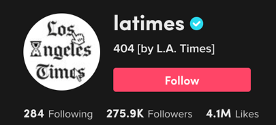
The Los Angeles Times: Everything is an experiment

The LA Times has also leaned into the creator-led approach setting up a team, named 404, with a specific brief to reach younger, more diverse audiences.
Angie Jaime, who runs the unit, has the title Head of Creator Content, perhaps the first of its kind ever for a mainstream newsroom. She has assembled a team of artists, filmmakers, cartoonists, journalists, and even a puppeteer to ‘invent new types of experimental content’, primarily for TikTok and Instagram.
It is still early days, but the TikTok strategy involves a number of regular formats, including the puppet-led Sorry Report – featuring Judeh the sheep – with a focus on climate change and the environment. Other initiatives include mini documentaries or explainers that are specific to Los Angeles, culture news, trends, and memes. Jaime argues that these approaches, which often tackle difficult subjects with a heavy dose of irony and sarcasm, appeal naturally to GenZ audiences in particular: ‘There’s so many things going on in this world now that are not solvable in the immediate future. And so what do you do about it? You kind of have to laugh in order to survive through it.’
Experimental visual storytelling from the 404 team


There are no immediate targets to make money. This is primarily an exercise in storytelling innovation: ‘Every single piece of content is an experiment into seeing what might work,’ says Jaime. ‘Is it actually achieving the goal, which is distributing information to a wider audience?’
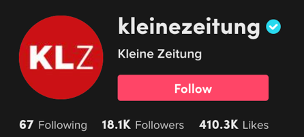
Kleine Zeitung: Regional news in accessible format
Austria’s largest regional publication has an ageing readership that has been transitioning slowly to digital. In the last year the paper has moved away from posting links to Facebook, where traffic has been declining, and rebuilt its social media team using a creator model. ‘I’m 28 and I feel like, “Oh my God, I’m so old”,’ says Larissa Eberhardt, Head of Social Media. ‘They are all Gen Z.’ The new team is charged with creating native content on TikTok and other social platforms to make the newspaper feel relevant to a new generation: ‘My colleague who is like super young (21) and has a really charming dialect and a sparkling personality. You can see that people are really attached to this person.’ Every day the team looks at data from their website to see which stories appeal to people ages 18–34 and then adapt those for TikTok by narrating it in a different way. They focus on regional news rather than national or breaking news, which is already comprehensively covered by the national broadcaster ORF.
‘I think what we realised is that the first sentence (first few seconds) is definitely the most important,’ says Eberhardt. ‘If we have images and a person on the first frame then people are like “OK this is catching my attention”.’ The team is careful to use easily understandable language, partly drawn from their long experience in publishing a children’s newspaper. ‘I had a concern that people would be like, “Oh, you talk to us in a paternalistic way, like we are dumb”, but it does work.’
The team has had success with topics that appeal to younger audiences, such as vaping in schools, a TikTok post which sparked a big debate. But Eberhardt concedes that it is not always easy to translate news to a platform where people are mainly looking to have fun: ‘The attention span is super, super short. We sometimes struggle with the fact that we can hardly ever enrich the content because the videos need to be so short.’

TNM: By young people for young people
The News Movement is a social start-up founded by former BBC and Wall Street Journal executives, which launched in October 2022 after almost a year in beta mode. Its mission is to deliver unbiased fact-based news, conduct investigations, and explain complex stories via TikTok and other social platforms.
All of those creating videos are drawn from that younger demographic and they bring an intrinsic understanding of the platform – and subjects likely to interest a Gen Z audience. Clodagh Griffin came to The News Movement from Yahoo! UK, where she had set up its TikTok account. She says the nature of the platform means the key challenge is to grab attention: ‘The first three seconds on TikTok is literally the most crucial. I guess it’s like the modern-day headline. It’s like posing a question or telling them why they should watch my videos.’ The pace of videos is extremely fast, with jump cuts and no pause for breath: ‘When I started here, they’d say, “Can you just, like, leave a second in between your sentences?” I was like, “No”.’ Griffin says her grandmother often needs to watch her videos four or five times, but young audiences can take in information much more quickly. The incorporation of memes, jokes, and sounds is another key component of the platform, according to another creator and filmmaker, Emma Bentley: ‘It seeps into the way that I, like, speak with my friends. We’re always quoting sayings on TikTok and in the office we’ll just shout a phrase or sing songs and everybody knows them.’
Like other creator-filled teams, The News Movement looks to match the light-hearted tone of the platform with information-rich, and often difficult, stories. There are explainers about British and US politics and the war in Ukraine and they have recently been trying out longer investigations: Griffin recently visited The Loop (below), which is a drug testing facility at the Parklife festival: ‘I got a tour around their lab – a “take me there” experience. What people come away with is information about why drug testing is important, the limitations of it, and be more informed.’ The video received around 1.5 million views. ‘My heart was so happy,’ says Griffin.
On-the-ground reportage is part of The News Movement’s mix

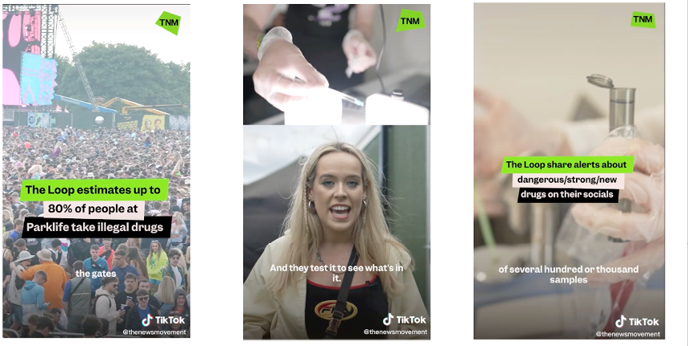
The News Movement is still learning what works but says that young people identify more with personalities than they do with brands: ‘It’s why TikTok allows creators and news organisations like us that are fresh to the scene to have resonance,’ says Head of Audience, Valentina Park. ‘The way that authenticity comes through is through our journalists, not necessarily through an opaque brand.’
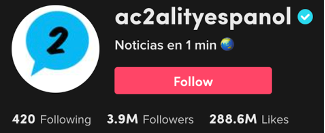
Ac2ality: Early adopter finds success
Another socially native start-up started by four Spanish friends in 2020,10 Ac2ality publishes a simple, fact-based news service in a TikTok-specific style. Its signature format was a ‘five key things you need to know today’ wrapped up in a minute. Today it publishes around six video stories a day in Spanish to its 3.9 million followers and runs an English service too.
The team puts its success down to the lack of competition at the time, strong visuals, and the simplicity of the language. ‘Young people want to understand what’s going on in the world. But even if the BBC was doing something similar, young people were not able to fully understand what they were posting,’ says Gabriela Campbell Gómez, one of the founders. ‘On some topics we added some memes, some jokes, making it really like colloquial and fun to watch.’ Gómez thinks that a personality-based approach, while helpful, is perhaps not as important for news as it is in other genres. Ultimately, she says it is the content that matters most. Despite Ac2ality’s audience success, they have not yet generated much revenue, though they have just started making sponsored posts for big brands and consultancy services are also part of the mix.
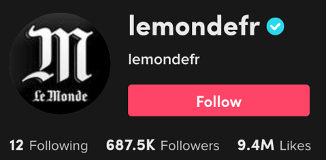
Le Monde: Creative and experimental techniques
The French upmarket daily started on TikTok in summer 2020 with a mission to explain the news. For the most part, posts on TikTok are bespoke to the platform. Content needs to be adapted, they say, for the much younger audience. The team itself, which is aged between 24 and 32, deploys a variety of creative techniques, including metaphors, drawings, fake video games, and acting. Having said that, to satisfy the algorithm’s need for volume, content from other platforms is now being re-versioned with some success. Le Monde has also experimented with live broadcasts on topics such as ‘the rise of manga in France’ and ‘why superheroes are so important’.
5.2. Newsroom-led approaches
An alternative to the creator approach is to put the whole newsroom at the heart of the operation, where TikTok becomes just one additional channel for distribution. This strategy is the one followed by many established news providers, especially those with existing video assets and skills (broadcasters).
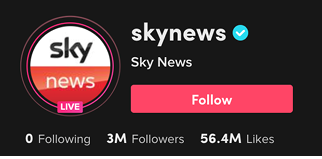
Sky News: TikTok is just another screen

The London-based broadcaster sees TikTok as another platform where it can take its trusted, reliable news. ‘I was very keen that we didn’t fall down the trap that a lot of publishers do, which is to try to be something they’re not,’ says Alan Strange, Head of On-Demand Content at Sky. ‘We do journalism. And we put our journalism on multiple screens. TikTok is another of those screens.’
Strange argues that at its heart TikTok is a relatively simple video platform where strong pictures play a big role. ‘If you have a correspondent on the ground, it is far better to use them, rather than a young creator,’ he says. Two of their most watched TikToks came from senior correspondent Stuart Ramsay – firstly in northern Italy at the start of the Covid-19 pandemic and then with his on-the-ground reporting from Ukraine.
Sky News’ TikTok content strategy is built on four pillars: 1) eyewitness reporting and access journalism, e.g., interviews with leading public figures; 2) being the first with breaking news moments; 3) explainers; and 4) live broadcasts. In the early days of the pandemic, Sky News gained millions of views for live streams of government press conferences, mostly driven by TikTok’s own app notifications. Another format that has been working increasingly well, around the Ukraine war in particular, is a map-based explainer driven by an expert in the studio. Most of these are re-versioned from television and so have a horizontal rather than vertical aspect ratio but they still work, says Strange. ‘When I first started doing this, one of the big problems I had was, nobody is going to watch it if it is 16x9, but our audience is now more forgiving. And that helps when you’ve got a 24-hour news video source in a television.’
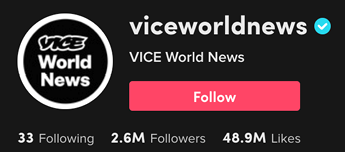
Vice World News: A year of growth and learning
 The digital-born publisher launched its TikTok channel at the end of 2021, focusing on short explanatory videos about international news. But the account really took off when Russia invaded Ukraine. ‘We had a correspondent, who was on the ground,’ says Matthew Champion, Editor-in-Chief for EMEA (Europe, Middle East and Africa). ‘He’s just kind of walking through Kyiv with the sound of the sirens in the background. He’s experiencing it, but he’s also telling you what’s going on.’ The report by Matthew Cassel (right), gained 21.6 million views. ‘It’s not very different from a more traditional news broadcast, but it’s just a bit more relevant.’ On-the-ground reporting has been a key part of Vice’s DNA for many years, but adapting this to the shorter attention span of TikTok users did take some work: ‘What we think about a lot of the time is what is the opening shot and what is the opening line,’ says Champion. ‘Our explainers always start with a question. That’s the curiosity gap. You’ve got someone in straightaway.’
The digital-born publisher launched its TikTok channel at the end of 2021, focusing on short explanatory videos about international news. But the account really took off when Russia invaded Ukraine. ‘We had a correspondent, who was on the ground,’ says Matthew Champion, Editor-in-Chief for EMEA (Europe, Middle East and Africa). ‘He’s just kind of walking through Kyiv with the sound of the sirens in the background. He’s experiencing it, but he’s also telling you what’s going on.’ The report by Matthew Cassel (right), gained 21.6 million views. ‘It’s not very different from a more traditional news broadcast, but it’s just a bit more relevant.’ On-the-ground reporting has been a key part of Vice’s DNA for many years, but adapting this to the shorter attention span of TikTok users did take some work: ‘What we think about a lot of the time is what is the opening shot and what is the opening line,’ says Champion. ‘Our explainers always start with a question. That’s the curiosity gap. You’ve got someone in straightaway.’
Vice’s content strategy mixes news explainers, on-the-ground reporting, and listicle formats. While the entire team can contribute to TikTok, in practice there is a limited number of staff who have the right skills and are able capture the right tone. These include Sophia Smith Galer, a former BBC reporter who is a TikTok personality in her own right. She points out that this style of video is increasingly being adopted by Instagram, Facebook (Reels) and YouTube (Shorts). ‘All the other social platforms are turning into a little version of TikTok so if you make something viral there, it is very likely to do well on the other platforms.’11
Like other publishers, Vice has benefited from the growing interest in serious news on the platform. ‘You can get news to work on TikTok, and you can do it in a way where you’re not having to resort to news presenters dancing or having to do bizarre things,’ argues Champion. ‘You don’t have to wear a suit and jacket to do it, but you can just tell them the news. It’s very encouraging.’
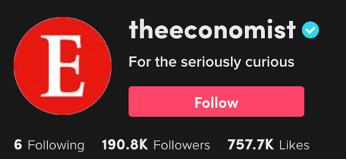
The Economist: Strong personality, no faces
It is perhaps not surprising that this upmarket magazine, which famously doesn’t use by-lines, takes a story- rather than creator-based approach. The publication has been surprisingly early to a number of social platforms and launched on TikTok in early 2022. ‘We had a hunch that you might not need faces as long as the content was engaging enough,’ says Liv Moloney, Head of Social Media: ‘Our brand has its own personality. It is witty and it’s about the way it’s done.’ The Economist strategy has also been to focus on quality rather than quantity, tackling topics that are ‘TikTok-y’ without compromising the brand. A video on why chickens are so large, for example, has been seen millions of times.
Chickens, politicians and cartoonists – part of an eclectic Economist strategy


The Economist’s mission is about explaining geopolitics and economics, and this chimes well with the interests of younger audiences, argues Moloney. One successful explainer was an interactive web feature on a Russian tank that they turned into a video: ‘That’s got a million views. And it’s a really nerdy, wonkish take on the war,’ she says. Economist videos with their high production values are the very antithesis of the quickfire jump cuts used by creators, but they seem to work just as well: ‘We’ll never be the first to tell you something’s happened, but we might be the first to explain it to you or explain it the best,’ says Moloney.
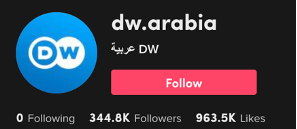
Deutsche Welle: Scaling TikTok across countries
 The German international broadcaster has nine accounts on TikTok for its different language services. But TikTok is being used in different ways depending on the market: ‘In Nigeria a funny video about the banning of Twitter did really well, but hard news about kidnapping less well,’ says Project Manager for Audience Development, Erika Marzano. ‘Serious news seems to perform more strongly in the Middle East,’ she says. While Deutsche Welle looks to reuse content across language services, it has also tried to develop the personalities behind the reporting, as this can help make a connection with the target audience: ‘On TikTok all videos look the same because we’re all editing with the same app,’ says Marzano. ‘What makes us recognisable is faces.’
The German international broadcaster has nine accounts on TikTok for its different language services. But TikTok is being used in different ways depending on the market: ‘In Nigeria a funny video about the banning of Twitter did really well, but hard news about kidnapping less well,’ says Project Manager for Audience Development, Erika Marzano. ‘Serious news seems to perform more strongly in the Middle East,’ she says. While Deutsche Welle looks to reuse content across language services, it has also tried to develop the personalities behind the reporting, as this can help make a connection with the target audience: ‘On TikTok all videos look the same because we’re all editing with the same app,’ says Marzano. ‘What makes us recognisable is faces.’
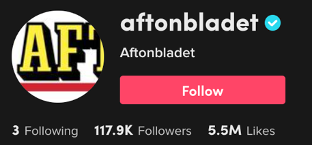
Aftonbladet: Tabloid approach, strongly branded
The Swedish tabloid launched its TikTok account in January 2022 and already has almost 120,000 followers. Those behind the strategy see value in showcasing faces but worry that a pure creator strategy would be too limiting for the range of content they want to cover: ‘Our competition is working with using the same person, building that rapport. But we feel that that is a big risk for us as a brand to be too connected to one single individual that can leave,’ says Future Editor, Nathalie Mark. Instead, Aftonbladet strongly brands all its TikTok videos with its distinctive black-on-yellow style, as a way of building the connection with audiences wherever they consume their news. As well as explainers, they focus on stories of interest to young audiences, including entertainment and breaking news. ‘If you’re doing news, being first is critical. Our most successful video [more than 1 million views] was climate protesters glued to the road and stopping an ambulance getting through by mistake. It hit all the right buttons,’ says Mark. ‘If our competition has a similar story before us, we won’t get those sorts of numbers.’
5.3 Correspondent accounts
While the accounts of individual journalists such as correspondents are common on platforms such as Twitter, they are relatively rare on TikTok. This may be because it takes more time to create and edit video, compared with text. But with some journalists looking for a new home after the Twitter takeover by Elon Musk, could this provide an alternative way to interact and engage with audiences?
CNN anchor Max Foster joined TikTok in 2019 when he noticed his own teenage children using the platform. He was initially impressed to find so many young vloggers and influencers talking about news, but also alarmed that much of it was misinformed. Foster’s aim is to provide basic facts, ‘not assuming any knowledge; simplifying without dumbing down’. Many of his videos are very short and often aim to answer a simple question, such as ‘What happens to the Queen’s corgis?’, which attracted 4.1 million views. Other videos are more playful, picking up a sound or a meme, or are based around a specific location where he is filming. He enjoys the conversation too, which frequently gives ideas for angles he can use back on television. Foster does not see himself as competing with other news organisations but rather with dancers and magicians. ‘You have to be in the same sort of headspace as them,’ he says.
The BBC’s Victoria Derbyshire has been another early adopter, with her quick news takes attracting almost half a million followers and TV anchor Jake Tapper of CNN posts regularly on TikTok, often as a way of promoting TV exclusives or offering behind-the-scenes takes on his work. Max Foster thinks we may see many more traditional journalists taking to the platform in the future: ‘One of the reasons people listen to me is I think I’m a bit older and they can tell I’m experienced and I’ve got the CNN brand and they can trust what I’m saying.’
5.4 Different approaches summarised
While a variety of strategies are being deployed, we find that broadcasters and some mass-market tabloids are mostly looking at TikTok as another way of distributing their existing content. This allows them to make the best use of existing assets, such as extensive news video footage or celebrity scoops. Newspapers and socially native brands, unable to compete on volume, have tended to create more bespoke content and have taken more risks with format and tone.
Creator-first approaches work well for publishers looking to create authentic content that is in keeping with the vernacular of the platform. The challenge is how to balance the personality of the creator with the brand they are trying to represent. Humour, music, and even puppets can make stories more accessible, but the jury is still out on whether this can develop loyalty and trust in the long term.
A more generic, brand-led approach is good for efficiency but the content may sit uneasily on a platform that has its own distinctive character and is designed for fun.
TikTok strategies for publishers

These are not hard and fast divisions, and publishers are often mixing these approaches in practice. Either way, there is common agreement that grabbing attention early, using simple language, having a light touch, and being open to a conversation are key ingredients for a successful TikTok account.
6. News creators and activists ↑
Just as Twitter to some extent democratised news creation for text, TikTok is doing the same for short videos. So-called social media influencers and personalities play a much bigger role on the platform than mainstream brands and journalists, according to Digital News Report research from 2021, in stark contrast with more traditional networks like Twitter and Facebook.
Figure 7
The lower prominence of journalists on TikTok is partly related to slow adoption by news organisations (though this research suggests this may be changing), lack of video skills, and the strong ‘creator culture’ on TikTok.
The platform encourages this with a creator fund, which is set to grow to around one billion dollars in the US over the next few years and double that globally.12 It is open to individuals creating any content, including news, but is not available to news organisations. But what does news from personalities and influencers look like on TikTok? While it is difficult to present a comprehensive picture, we have gathered below a few examples of the work of creators and activists and the impact they are having.

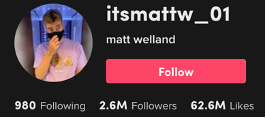
Matt Welland has 2.6 million followers, which is about four times as many as BBC News. He posts several videos each week which deal with offbeat news and threats to the planet such as nuclear war and asteroid attacks. Each video is around one minute long and starts with an eye-catching statement such as ‘2022 just got even crazier’ or ‘We’re on the verge of World War 3’. A recent video about a Russian nuclear submarine going missing with doomsday nuclear weapons on board got 8.2 million views. The submarine has since been sighted in the Barents Sea with experts suggesting this is not unusual.13
Eye-catching hooks are part of the formula



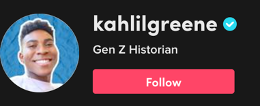
Kahlil Greene is a self-styled Gen Z historian with around 580,000 followers on the platform. He aims to cast light on the contribution of Black Americans to lesser-known or misunderstood moments in history. He was the first black student president at Yale and is part of a group of social media influencers using their platforms to question what they were taught at school. His first video on TikTok in early 2021, which talked about the whitewashing of Martin Luther King’s legacy, went viral with over 1.5 million views. He’s also posted about current issues, such as the need for young people to vote in the mid-term elections and racial slurs being used by Los Angeles councillors. Greene was one of a small number of influencers asked to attend a White House briefing after Russia’s invasion of Ukraine: ‘I’m definitely for more briefings with independent reporters through TikTok because I think it democratises information sharing and it makes it so that we don’t have to rely on huge news corporations,’ he says. Greene has noticed more serious news on the platform and more discussion of race and social justice since the death of George Floyd: ‘I like the freedom that TikTok gives me, I can wear many different hats. I don’t have to necessarily box myself in the way that I would if I was like working at like one large company with a specific mandate.’
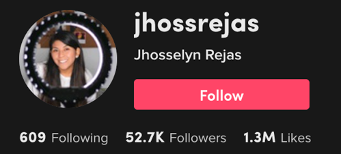

Jhosselyn Rejas is a 27-year-old activist and TikTokker who played a part in youth protests that brought down the Peruvian interim president in November 2020. Rejas downloaded the app for fun during Covid-19 lockdowns but was soon inspired to post about politics and social justice by a Mexican feminist, among others. She says that the vast majority of young people were on the app in 2020 because of the pandemic so it became the natural way to organise pro-democracy protests: ‘It was a tool that not only informed about what was happening in a simple way, but you also saw your favourite TikTokker encouraging you to go on a march, and that attracted more young people,’ says Rejas. She posted her own experience of police brutality after two students were killed, which was widely viewed and shared.
Activism with a human face

Two years on, she says TikTok is still the most important app for young Peruvians: ‘We no longer only go to TikTok for dances, we go to find out what is happening in the world,’ says Rejas, although her posts do still feature music and dancing along with the politics. ‘Sometimes the news media makes it very difficult to understand, so we go to TikTok to have someone explain what’s going on. It’s much more fun and innovative than TV,’ she adds. But does Rejas see herself as an activist or a journalist? ‘I see myself more as an activist,’ she says. ‘Although I challenge myself to always tell the truth, I have a political position, which goes beyond being Left or Right. I not only share information, but also give my opinions, and that will always be subjective.’
6.1 Co-opting creators – a case study from Italy
The creativity and passion of young TikTokkers is something that many publishers know they need to capture if they are going to engage the next generation of news consumers. Many news creators have large followings but find it hard to build or sustain a business. So, could this be an opportunity for publishers? In Italy, the publisher Ciaopeople has been experimenting with this idea.
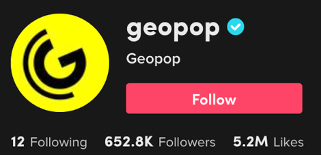
Geopop is a popular science project started as a hobby by geologist Andrea Moccia in 2018: ‘One of my friends told me, why don’t you do videos where you can explain scientific stuff? So, I bought a camera and microphone and I started to make videos and realised that it was really cool.’ Ciaopeople noticed Andrea’s passion for the subject and approached him during lockdown in 2020 with the idea for a joint venture where he could turn this into a full-time job. Since then, the community (followers) has gone from 400,000 to around 6 million Italians, including around 650,000 followers on TikTok. Being part of a bigger company has provided the capital needed to grow – there is now a team – and access to specialists on branding and social distribution. ‘If you look at one of the first videos where I was alone, it’s embarrassing,’ says Moccia. ‘I cannot watch the first one,’ he says. Geopop videos have a strong graphical style and the team has recently incorporated higher production values and 3D animations – always packing as big a punch as possible in the first three seconds.
Visual storytelling at Geopop helps to explain complex ideas


Initially, Moccia wasn’t convinced about TikTok but has since changed his mind: ‘Of course, we all like dancing and singing, it’s an entertainment,’ he says. ‘But I think younger people are very interested in geopolitics. In mechanics, engineering. It’s impressive. It’s unbelievable.’ He notes that videos are now longer than they used to be, with six- and ten-minute explainers often some of the biggest hits.
Geopop is part of a verticals strategy for Ciaopeople that includes channels for news (Fanpage), cooking (Cookist), Green (Ohga), Animals (Kodami), and an artistic collective called The Jackal. All of these publish on multiple social platforms but TikTok is currently generating much of the growth. ‘We are succeeding in combining creators and publishers,’ says CFO Fabrizio Barbato, who is looking to generate advertising revenue across multiple platforms, including a spin-off magazine. ‘What we saw is that users are engaged more with the person than with the brand. If we can do both – because the users are engaged with Andrea and the Geopop brand too – that’s the perfect combination,’ says Barbato, who is looking for more opportunities to team up with creators in the future.
6.2 The future for news creators on TikTok
In practice, most independent news creators on TikTok are not getting rich. Many say the creator fund pays such small amounts of money – compared with YouTube – that in most cases it is not worth their time. Techniques such as product placement and sponsored posts, which are widely used in fashion and entertainment genres, are much harder to pull off in news and there is no display advertising option yet.
Instead, news creators tend to use TikTok to build their personal profile so that they can make money elsewhere – even in some cases by joining a conventional publisher or broadcaster. But others will not wish to constrain their creativity and many engage with TikTok for the fun of creating and sharing their ideas, or because they feel passionately about an issue or cause. But as this content expands it may become more important to better signal the perspective of a particular creator and the reliability of their content.
7. What next for TikTok and news? ↑
In this final chapter, we explore how news might develop on the platform and ask publishers how they think TikTok could better support journalism.
TikTok itself did not set out to be a platform for news and it remains ambivalent about a genre that is often difficult or controversial and tends not to make money. With Facebook and Twitter losing traction, many publishers are looking to TikTok as a way of replacing that engagement, but the tone of the platform and the way it works right now is not always a natural fit for journalism. Outlined below are four ways in which publishers hope this might change.
7.1 Better promotion of high-quality news content
On TikTok, publisher accounts tend to be treated in a similar way to any other news creator. Some news accounts are marked with a blue tick, but it is not clear what this means and the process of getting verified is opaque.14 Our research shows that many publishers with a strong track record for trusted content including debunking and fact-checking do not yet have a blue tick, especially outside the US and Western Europe. Few of the top news sources in Hungary, Bulgaria, or Slovakia have blue ticks, for example.15 A range of trusted sources in Nordic countries have no blue marks, and verification is extremely patchy across Latin America, Africa, and Asia, areas where misinformation is rife.
During the height of the Covid-19 pandemic, TikTok promoted live streams of government press conferences and rolled out an information hub for official information. TikTok also set up an election centre for the recent US mid-terms, providing access to authoritative information, and using additional internal links to election content to drive usage.16 TikTok also partners with fact-checking organisations to help identify false information. But managing these processes on a global scale, in multiple languages, remains an enormous task as the platform grows. While recognising the challenges, publishers would like TikTok to do much more to flag the reliability of news creators: ‘They should address the issue of the reputation of users, to understand if that creator can be reliable in a journalistic way,’ says Fabrizio Barbato from the group behind Italy’s Fanpage.
Publishers point to YouTube’s ‘breaking news shelf’, where reliable brands are promoted whenever a big news story happens, and would like to see similar approaches taken by TikTok. Others would like TikTok to create a dedicated space for news within the app.
7.2 More transparency about the removal or blocking of news content
Many news organisations were initially wary of TikTok’s Chinese ownership and the potential for censorship, and these worries have not gone away. A recent report from ARD’s Tagesschau found that TikTok had been preventing comments from being displayed under videos if they contained certain keywords:17 ‘We found that TikTok was blocking comments that included words such as “gay”, such as “queer”, which is something that is very unusual on other platforms,’ says Patrick Weinhold, Head of Social Media for Tagesschau. TikTok has since revised its approach to these word filters, but worries persist on a range of other issues. TikTok adds black ‘warning screens’, for example, to posts that might contain images of violence, such as political protests, which means they are much less likely to be watched by users. While news organisations recognise that it is important to protect younger TikTok audience from shocking images, they feel that these rules are overly restrictive and in practice stop them covering legitimate topics of public interest.18
Many publishers would like the platform to treat their content differently, recognising their expertise and sensitivity in covering stories like war and protests, so that important news is not blocked by these algorithms. They also want more openness about why content is removed or downgraded. ‘With Facebook, it is much more transparent,’ says Larissa Eberhardt at Kleine Zeitung in Austria. ‘We get to meet them and work with them, but with TikTok they often don’t answer any questions.’ TikTok itself recognises that moderation decisions can be contentious, but says that creators are notified when content is removed, and there is an opportunity to appeal.19
7.3 Better monetisation of content
Commercial publishers would like to find ways to be compensated for the value they provide to the platform. This could be direct payments or access to the creator fund that allocates money for popular posts. Short videos do not lend themselves to interruptive advertising, but publishers would like the ability to put onward links to websites or apps, which is currently very limited,20 where traffic can be monetised via advertising or subscription. These links would also make sponsored posts more viable as it would provide a way for advertisers to track further interest. ‘To monetise this kind of content is a big opportunity for the media industry,’ says Maurice Jalfon, Head of Social Media for Infobae in Argentina. The Washington Post has started to experiment with sponsored posts for brands, though these are not produced by the newsroom TikTok team but by a separate creative group. Others are considering developing genres or series that are ‘brought to you by a particular advertiser’: ‘We’ve been trying to find a partner to support a video series of the World Cup on TikTok,’ says Paula Miraglia, CEO of Nexo Jornal in Brazil. ‘I think this could be more interesting and more aligned with what our audience would expect.’
It is still relatively early days and platform features are constantly changing. TikTok has raised the maximum length of videos to ten minutes and is pushing longer live streams. It is also trialling a subscription model, similar to Amazon’s live-streaming platform, Twitch, in which fans pay to gain better access to a creator’s channel. These approaches may open up more monetisation options in the future but are mainly aimed at incentivising creators. Until there is a clearer monetisation path for publishers, investments are likely to be constrained.
7.4 Improved audience data and tools
Publishers would like more detailed and more timely demographic information about who has viewed posts, with more data about how particular posts have performed. This will make it easier to demonstrate value internally as well as to optimise content for the platform: ‘I think having more audience and demographic data would be huge,’ says Angie Jaime at the Los Angeles Times. ‘Our biggest quandary right now is figuring out consistency of performance, how we can reach more niche or wider audiences.’
Publishers would also like better functionality for being able to edit and manage workflows across accounts (suitable for a business user), rather than being tied to a single user or phone. Some publishers are unhappy with the moderation tools and options around live events.
Conclusion ↑
The nature of social media is being reshaped, with TikTok riding a wave of growth, driven by the creativity and energy of young people. As this research has shown, publishers across the world are flocking to the platform, partly to engage and build relationships with this younger demographic, but also to experiment with vertical video storytelling formats, which are becoming ubiquitous across social media platforms.
Publisher adoption is unevenly distributed, however, with the most enthusiasm in parts of Western Europe, South-East Asia, Latin America, and the US, and less interest elsewhere. Some publishers remain worried about Chinese ownership of the platform and its potential risks; others fear that the very short video format risks trivialising important news stories. The lack of opportunities to monetise content is further limiting investment by publishers.
News organisations are also concerned that TikTok is becoming a new home for fake news stories, manipulated media, and other types of misinformation.21 Fact-checking, debunking, and news literacy have become an increasing focus for many publishers as these threats become more real. But some worry that these efforts are not being sufficiently prioritised by TikTok itself. More generally, publishers would like much more engagement with the specific issues of publishing as well as content that is ‘good for society’.
These issues closely match the dilemmas publishers have faced with other social platforms in the past – namely how to balance short-term opportunities with longer-term risks. The extra costs that come with creating bespoke content on the platform, together with very limited attribution and onward-linking options, makes the cost/benefit analysis even tougher in this case.
For those who are experimenting on the platform, there is no single recipe for success. Many publishers use a strategy based on hiring young creators who are native to the platform and its vernacular. This approach has connected strongly with audiences and brought critical acclaim but can make it harder to re-version content for other social platforms. Others have focused on showcasing the assets of the entire newsroom, including more experienced correspondents and anchors, delivering greater scale and flexibility but often without the same personal touch.
Either way, interviewees agree that content needs to be short, accessible, and engage audiences in the first few seconds. But that does not necessarily mean dumbing down. ‘Need-to-know’ stories about Covid-19 and Ukraine have gained very large audiences on TikTok, and publishers say there is widespread appetite for learning new things and understanding complex stories.
Looking to the future, we can expect videos to get longer than the current 30–60 second average, offering more opportunity for deeper engagement. TikTok’s audience is getting older so there is a chance to address a wider range of needs. But there are also signs that avoidance may be kicking in as the amount of news on the platform increases. Early adopters say it is much harder to grow followers than it was even a year ago, and some say that the average view count has been falling too. This may be a function of greater competition for attention, with more creators and publishers jostling to gain prominence in feeds.
This research is a snapshot of a moment in time, exploring how some publishers are adapting to one vibrant and dynamic social network. But it is also part of a wider trend; namely, that more journalism in the future will be consumed in new formats, using new technology, and within contexts that may seem unthinkable today. In that sense, the processes of experimentation and discovery illustrated in this report will be critical.
About the Author ↑
Nic Newman is a Senior Research Associate at the Reuters Institute and has been lead author of the Digital News Report since 2012. Nic also writes an annual study looking at the latest trends in technology and the business of journalism. He is a consultant on digital media, working actively with news companies on product, audience, and business strategies for digital transition.
Acknowledgements ↑
The author is grateful to the many media executives, creators, and other experts who gave their time to be interviewed for this report. The research team at the Reuters Institute provided valuable input at various stages, including thoughtful comments on the manuscript. Thanks also to Georgia Newman for her detailed research in helping to identify top news publishers on TikTok in more than 40 markets and to Alex Reid for keeping the publication on track at all times.
Published by the Reuters Institute for the Study of Journalism with the support of Google and the Google News Initiative.

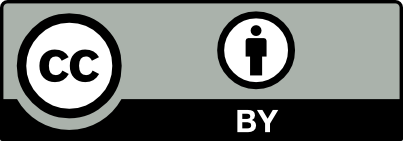
This report can be reproduced under the Creative Commons licence CC BY. For more information please go to this link.
Appendix A - List of interviewees ↑
Positions held at the time of the interviews
Appendix B ↑
Footnotes
3 Publishers with more than 4% national online reach in the 2022 Digital News Report survey (see Methodology for more details), based on representative samples of ≈ 2,000 people. The number of countries and markets is 44, not 46, because TikTok is banned in India and is not available in Hong Kong.
4 We defined 4% online reach as the key threshold across countries, a figure which shows significant national reach but does not tend to exclude important offline TV and print brands.
6 Samples in African countries are younger (55 and under) as older groups tend not to be online, which may also account for higher relative numbers here.
9 Micah Gelman, Director of Editorial Video at Washington Post
10 The four founders are Gabriela Campbell Gómez, Daniela Álvarez, María Murillo, and Paula Muñoz.
11 Interview from Reuters Institute/BBC event, ‘Young People and Their News Habits’, 27 September 2022.
12 The creator fund is currently only available in the US, the UK, Germany, Italy, France, and Spain.
14 TikTok says that it considers a number of factors before granting a verified badge, such as whether the notable account is authentic, unique, and active.
15 These include Bulgarian National Television, the most trusted news brand in the country according to the Digital News Report 2022. The Czech brands missing include Czech TV, the second most trusted news source. Top Finnish brands such as the highly read Iltalehti are without a tick. In Peru, the news brand Trome is unverified, despite posting several times a day and having 486,000 followers and 18 million likes.
16 TikTok's commitment to electoral integrity. TikTok has also created in-app guides for the 2022 Kenyan general election, the 2022 Brazilian general election, and the 2022 Australian federal election.
18 TikTok says it does permit some public-interest content that would normally be removed, under limited circumstances, such as educational, documentary, scientific, artistic, satirical content, or counterspeech.
20 Accounts with more than 1,000 followers can add an external website to their bio.
In every email we send you'll find original reporting, evidence-based insights, online seminars and readings curated from 100s of sources - all in 5 minutes.
- Twice a week
- More than 20,000 people receive it
- Unsubscribe any time


